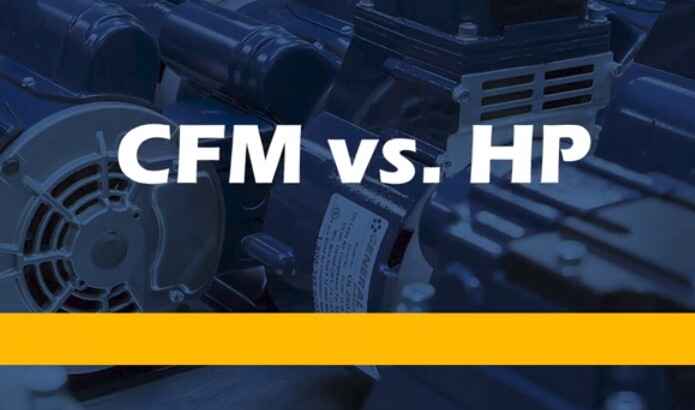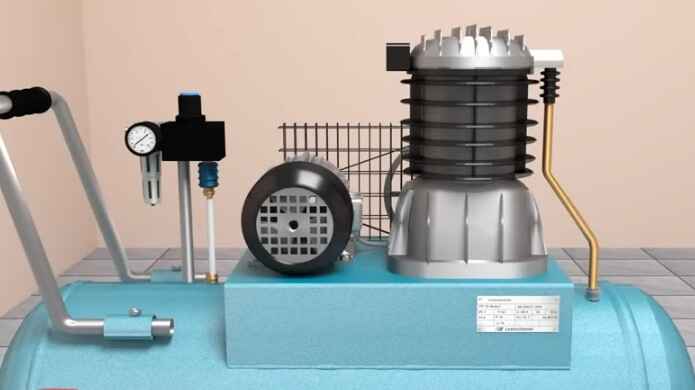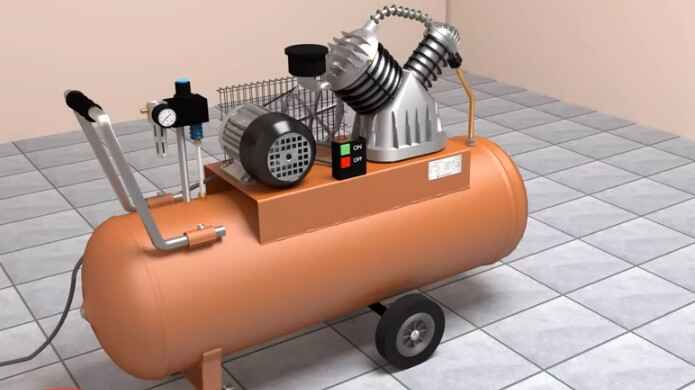The Air Compressor HP to CFM (horsepower to cubic feet per minute) chart illustrates the relationship between a compressor's horsepower and its airflow capacity. It helps users select the right compressor for their needs by indicating the volume of air produced at different horsepower levels.
Welcome to our comprehensive guide on understanding the critical relationship between horsepower (HP) and cubic feet per minute (CFM) in air compressors. Navigating the intricacies of these two metrics is essential for anyone looking to optimize their compressed air systems. In this blog post, we'll break down the Air Compressor HP to CFM Chart, providing valuable insights to help you choose the right compressor for your needs and maximize efficiency in various applications. Let's dive into the dynamics that power your pneumatic tools and processes.

Regarding air compressors, HP (horsepower) is one of the most commonly used terms. However, many people need to fully understand what HP means and how it affects the performance of an air compressor.
Firstly, it's essential to understand that HP is a measure of power, not airflow. It refers to the work an air compressor motor can perform in a certain amount of time. The higher the HP, the more powerful the compressor motor is.
However, it's important to note that a higher HP doesn't necessarily mean a higher CFM (cubic feet per minute) output. CFM is a measure of airflow, and it is affected by factors such as the size of the compressor tank, the type of compressor pump, and the pressure setting.
Many air compressors with lower HP ratings can still deliver high CFM output, especially if designed for specific sandblasting or spray painting applications.
When choosing an air compressor, it's essential to consider both the HP and CFM ratings, as well as the specific requirements of your application. A compressor with a higher HP rating may be necessary for heavy-duty applications, while a lower HP compressor may be sufficient for lighter tasks.
Understanding the relationship between HP and CFM is crucial when choosing an air compressor. While HP is a measure of power, it does not necessarily correlate with CFM output. By considering both factors and matching them to your specific application, you can ensure that you choose the right air compressor for your needs.

Understanding CFM
As I researched air compressors, I found that CFM (Cubic Feet per Minute) is an important factor to consider when selecting an air compressor. CFM measures the air volume an air compressor can deliver in a minute. It is a crucial factor to consider because it determines the air compressor's performance.
When considering CFM, it is crucial to know the air requirements of the tools you will use. Each tool has a specific CFM requirement: the amount of air it needs to operate efficiently. If the air compressor cannot deliver the required CFM, the tool may not work at its full capacity, or it may not work at all.
It is also important to note that the CFM of an air compressor decreases as the air pressure increases. This means that the CFM rating of an air compressor is usually specified at a certain pressure level, such as 90 PSI.
To determine the CFM requirement of your tools, you can refer to the manufacturer's specifications or use an online CFM calculator. Once you have determined the CFM requirement of your tools, you can select an air compressor that can deliver the required CFM at the required pressure level.
In summary, understanding CFM is crucial when selecting an air compressor. It is important to know the CFM requirement of your tools and select an air compressor that can deliver the required CFM at the required pressure level.
Air Compressor HP to CFM Conversion Chart
When selecting an air compressor, knowing how much air you need to power your tools is crucial. CFM (cubic feet per minute) measures the volume of air that an air compressor can deliver. Horsepower (HP) is the measurement of the motor's power output that drives the air compressor pump.
You can use an air compressor HP to CFM conversion chart to determine the CFM you need. This chart shows the relationship between the horsepower of an air compressor and the corresponding CFM output.
Here is a sample air compressor HP to CFM conversion chart:
HP | CFM at 90 PSI |
|---|---|
1 | 3.5 |
2 | 7.0 |
3 | 10.5 |
4 | 14.0 |
5 | 17.5 |
6 | 21.0 |
7 | 24.5 |
8 | 28.0 |
9 | 31.5 |
10 | 35.0 |
The CFM output is measured at 90 PSI, a common working pressure for many air-powered tools. You can adjust the CFM output accordingly if you need a different pressure.
It's essential to remember that this chart is just a guideline. The actual CFM output of an air compressor depends on many factors, including the size and design of the compressor pump, the motor efficiency, and the ambient temperature and humidity.
When choosing an air compressor, selecting one with a slightly higher CFM output is always a good idea than you need to ensure you have enough power to run your tools.
Factors Affecting HP to CFM Conversion
Regarding air compressors, several factors can affect the conversion of horsepower (HP) to cubic feet per minute (CFM). Understanding these factors is essential to ensure you choose the right air compressor.
The compressor's design is one of the primary factors affecting HP to CFM conversion. Different compressor designs have varying efficiencies, impacting how much air they can produce at a given horsepower. For example, a reciprocating compressor may be more efficient than a rotary screw compressor, resulting in a higher CFM output for the same HP rating.
Another factor affecting HP to CFM conversion is the compressor's age and maintenance history. Over time, compressors can experience wear and tear, impacting their efficiency. Regular maintenance, such as changing filters and oil, can help ensure that the compressor operates optimally.
The ambient temperature and humidity can also affect the HP to CFM conversion. Compressors generally produce less CFM output in hot and humid conditions, as the air is less dense. This is why it's essential to consider the operating environment when choosing an air compressor.
Lastly, the tool or equipment used with the air compressor can also impact the HP to CFM conversion. Different tools have varying air consumption requirements, affecting the amount of CFM needed to operate them. It's crucial to ensure that the air compressor you choose can meet the CFM requirements of the tools you plan to use.
Understanding the factors affecting HP to CFM conversion is essential to ensure you choose the right air compressor. By considering the compressor's design, maintenance history, operating environment, and tool requirements, you can make an informed decision and ensure you get the most out of your air compressor.
How to Read the Conversion Chart
As I mentioned earlier, the air compressor HP to CFM conversion chart is a useful tool to determine the airflow capacity of the compressor. However, it can be unclear if you are unfamiliar with how to read it. In this section, I will explain how to read and make the most of the conversion chart.
The first thing to note is that the chart has two columns: one for HP and the other for CFM. The HP column represents the compressor's horsepower, while the CFM column represents the cubic feet per minute of airflow.
To use the chart, find the horsepower rating of your compressor in the left column and then read across to find the corresponding CFM rating in the right column. For example, if your compressor has a horsepower rating of 5 HP, you can find the CFM rating of 16.6 CFM in the chart.
It's important to note that the CFM rating depends on the compressor's horsepower rating, as well as other factors such as the size of the tank and pressure rating. Therefore, choosing a compressor with a horsepower rating that matches your specific needs is important.
In addition to the conversion chart, there are other factors to consider when choosing an air compressor, such as the intended use, the type of compressor, and the brand. By considering these factors, you can ensure that you choose the right compressor for your needs.
In summary, the air compressor HP to CFM conversion chart is a useful tool to determine the airflow capacity of your compressor. To use the chart, find the horsepower rating of your compressor in the left column and then read across to find the corresponding CFM rating in the right column. Remember to consider other factors when choosing an air compressor to ensure that it meets your needs.

Impact of Altitude on Conversion
When it comes to converting horsepower (HP) to cubic feet per minute (CFM) for air compressors, altitude can significantly impact the conversion. The air is less dense at higher altitudes, which means less air is compressed into the same volume, resulting in a lower CFM output.
To account for the impact of altitude, it's important to use a correction factor when converting HP to CFM. The correction factor considers the decrease in air density at higher altitudes and adjusts the CFM output accordingly.
The correction factor for altitude can be calculated using the following formula:
CFM (corrected) = CFM (measured) x (14.7 / atmospheric pressure) x (temperature + 460) / 530
Atmospheric pressure is measured in pounds per square inch (PSI), and temperature is measured in degrees Fahrenheit.
It's important to note that the correction factor for altitude is not a fixed value and can vary depending on the specific altitude and atmospheric conditions. Therefore, it's essential to consult a reliable HP to CFM conversion chart considering altitude and other relevant factors.
In summary, the impact of altitude on the conversion of HP to CFM for air compressors cannot be ignored. By using a correction factor that considers altitude and other relevant factors, it's possible to accurately determine the CFM output of an air compressor at any altitude.
Impact of Temperature on Conversion
When calculating the CFM of an air compressor, it's essential to consider the temperature of the compressed air. The reason for this is that temperature affects the density of the air, which in turn affects the volume of air that can be compressed.
As the air's temperature increases, the air's density decreases. This means that the same volume of air at a higher temperature will have a lower mass than the same volume at a lower temperature. This decrease in density results in a lower CFM rating for the compressor.
To illustrate this point, let's consider an example. Suppose we have an air compressor with a 5 HP motor and a CFM rating 20 at 90°F. If we were to increase the compressed air temperature to 120°F, the CFM rating would decrease to approximately 17.5 CFM. This is because the density of the air decreases as the temperature increases, resulting in a lower volume of air being compressed.
It's important to note that the impact of temperature on CFM is not linear. In other words, a small increase in temperature can have a significant impact on the CFM rating of the compressor. This is why it's important to consider the compressed air temperature when selecting an air compressor for a particular application.
In addition to the impact on CFM, temperature can also affect the performance and lifespan of the compressor itself. Higher temperatures can cause increased wear and tear on the compressor components, reducing efficiency and a shorter lifespan.
Overall, it's important to consider the impact of temperature on the CFM rating of an air compressor when selecting a compressor for a particular application. By considering temperature, you can ensure that you choose a compressor that will provide the necessary CFM for your needs while also providing reliable performance and a long lifespan.
Conclusion
In conclusion, understanding the relationship between air compressor HP and CFM is crucial for selecting the right compressor for your needs. It is important to note that the HP rating is not the only factor to consider, as the CFM rating also plays a significant role in determining the compressor's performance.
As we have seen in the previous sections, the HP to CFM ratio varies depending on the type of compressor and its application. Reciprocating compressors generally have a higher HP to CFM ratio than rotary screw compressors, but they also tend to be louder and require more maintenance.
When selecting an air compressor, it is important to consider the specific requirements of your application, such as the required pressure, duty cycle, and air quality. It is also important to ensure that the compressor is properly sized for your needs, as an undersized compressor can lead to decreased efficiency and increased wear and tear.
Understanding the HP to CFM ratio is an important step in selecting the right air compressor for your needs. By considering all of the relevant factors and taking the time to research your options, you can ensure that you select a compressor that will provide reliable and efficient performance for years to come.